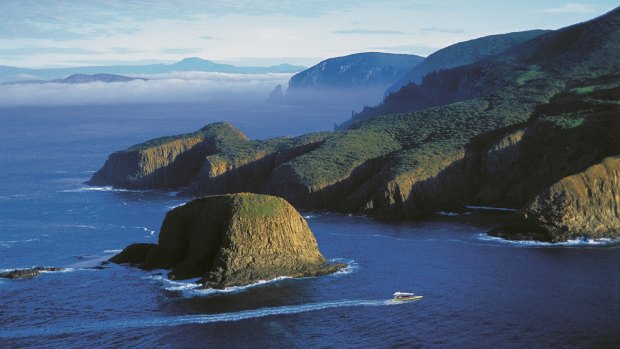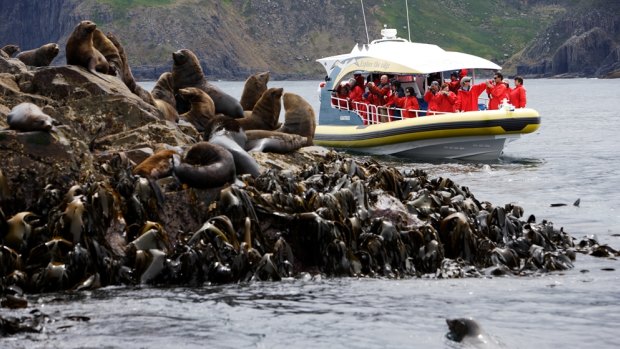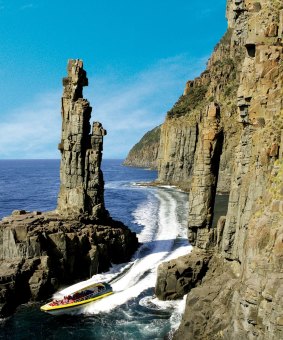This was published 3 years ago
Bruny Island wilderness cruise, Tasmania: Seals, dolphins and rocks that breathe
By Jim Darby

Bruny Island Cruises - sailing around The Friars off the coast of South Bruny.
A few minutes out from the pier, our skipper Huw Griffiths slows the boat and sets our sights up to Grassy Point to acknowledge the Nuenonne, the first inhabitants of Bruny Island. Back in the day, Griffiths says, it was the Nuenonne women's task to dive for food. Their endurance was so good, the French expeditioners who sailed here in the 1800s thought they must have drowned until, much to their surprise, they'd surface after five minutes under water.
Our boat is an improvement on anything those French sailors had. This one is purpose-built and seems perfect for the purpose; something like an overgrown version of one of those rigid-inflatable boats commandos use, with some more comfort in the seating, but plenty of adventure in the sailing.
I also have a little bit of outboard envy; my tinny is powered by a 30-horsepower Yamaha outboard. This one has three 250 horsepower Yamaha motors. That's 25 of my outboards, but then I'm not showing 40 or so people the wild cliffs and wildlife along the coast of Bruny Island in the rolling swells of the Tasman Sea.

A colony of fur seals at The Friars.
We're out for a three-hour cruise with Pennicott Wilderness Journey's Bruny Island Cruise, with skipper Griffiths supported by informed and informative deckhand Jamie Kingston.
Before we leave the pier, Kingston gives us a briefing on the sunny deck of the Bruny Island Cruises visitor centre, advising us to take one of the red ponchos they use for spray jackets. "No need to search for your size," he says, as "one-size fits nobody."
Out of Adventure Bay and around the corner from Grassy Point, we motor slowly past giant kelp forests, swinging in the swells like Pacific dancers. The kelp can grow as much as a metre in a day, but is vanishing from Tasmania's coast as the warmer currents of climate change intrude.

The Monument, a soaring natural statue that somehow shattered away from the coast and its cliffs.
We look inside sea caves and pass the huge rock stack known as The Monument, a soaring natural statue that somehow shattered away from the coast and its cliffs.
Then we slow beside the feature they call Breathing Rock. Blowholes on the coast are a wondrous thing anywhere. This one sucks in the surf and sends out a spray, as most of them do, but then the spray floats in the air like a misty veil, and as the swells move in and out, the sound is just like drawing breath.
Further down the coast, we arrive at some small islands known as The Friars to see a colony of Australian fur seals, sleeping, flopping or flapping on the rocky ledges that face the sea. They're all, or almost all, males here, we're told.
Eventually the alpha male will make a swim for it to Flinders Island or Wilsons Promontory in Bass Strait, do some serious breeding, and then bring a young male back here to the colony. Meanwhile, they're relaxing on the rocks, in their men's shed, with a hierarchy that has the boss seals at the top. Nothing new in the natural world.
There's another colony, not far away but totally separate and settled a little more sparsely on their rocks. These used to be known as New Zealand fur seals, but they're now so well established here they're a sub-species called long-snouted or long-nosed fur seals.
After the seals we spott a shy albatross, winging its way through the swells. These remarkable birds only breed on some small islands off the Tasmanian coast and live for around 60 years. They like to travel and have been seen as far afield as South Africa or the US Pacific coast. They've been tracked covering 1000 kilometres inside 24 hours.
Then comes maybe the highlight in a cruise of many natural highlights - a pod of common dolphins picks up our path and starts riding the wake of the boat like submarine surfers. Whales aren't uncommon, but we don't see any on this trip.
The boat proves remarkably manoeuvrable in Griffiths' hands and he managed to ride the swells in such a way that he almost smooths them out. Because the boat isn't enclosed, there's a far better sense of connection with the seascape and wildlife.
A tip? Make sure you're OK on the water, and think about some sea-sickness medication if you're not. Adventure Bay might be as smooth as glass, but around the corner and into the Tasman Sea, there's sure to be some swell.
Jim Darby was a guest of Bruny Island Cruises, see brunycruises.com.au
Sign up for the Traveller Deals newsletter
Get exclusive travel deals delivered straight to your inbox. Sign up now.